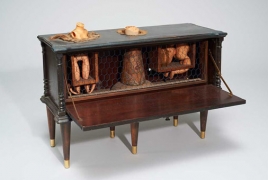Norton Simon Museum exhibit explores unsettling works of art September 2, 2016 - 17:01 AMT PanARMENIAN.Net - The Norton Simon Museum presents Dark Visions: Mid-Century Macabre, an intimate exhibition that explores unsettling and thought-provoking works of art by some of the 20th century’s most influential artists, among them Bruce Conner, Joseph Cornell, George Herms and Edward Kienholz. The 14 works on view—comprising assemblage, painting and lithography—demonstrate the ways in which artists have portrayed humankind’s struggle to face death and life’s tribulations—whether through catharsis, psychosis or a portrayal of horrors, Art Daily said. While the works on view span media and decades, many share similar characteristics: the palettes are muted blacks and browns, space is restricted, and figures and forms regularly find themselves in boxes, or (even) include boxes themselves. These boxes suggest a chaos, a struggle to overcome the confines of the frame. With Lust Murder Box No. 2 from 1920–22, artist Kurt Schwitters hired master wood craftsman Albert Schulze to make a small box using intarsia—a wood veneer inlay technique—so that the work resembled his collages and the constructed overlaid forms of architecture in his famous Merzbau studio. According to Kate Steinitz, an early collaborator of Schwitters and donor of the artwork to the Museum, the title is based on a damaged plaster figure that once lay in the box and which the artist daubed with lipstick to make it look “bloody.” Using more traditional materials, Jack Edward Stuck envisions himself as a silhouetted profile strapped into a gas chamber chair in his painting Self-Portrait from 1960–61. The viewer voyeuristically looks in through one of the portholes of the chamber to see the artist calmly awaiting execution. Stuck does not rely on an overflow of materials to impart a sinister feel. The flat handling of the paint and the faint pencil lines lend a disquieting sense of foreboding. A more viscerally vicious act is depicted in the lithograph Combat from 1965, by Leon Golub. Here, two forms are intertwined in violence, as one combatant raises a fist over the other. The bold, slashing lines lend themselves to the frenetic pace and anxiety of the physical confrontation—so much so, that there is no delineation between one assailant and the other in this struggle for power. Golub does not hide anything from viewers; he puts this clash between two bodies front and center, forcing them to confront their own fears of brutality. Other works of art in the exhibition include Jess’ illuminated Assembly Lamp Eight, 1966—a seemingly old-fashioned lamp whose shade is comprised of photographs and glass lantern slides; Conner’s HOMAGE TO MINNIE MOUSE, 1959, a dark and mesmerizing assemblage with decomposing architectural features and fabric; Kienholz’s The Secret House of Eddie Critch, 1961, an old writing-desk inhabited by dismembered doll parts and animal fur; and Connor Everts’ Now the Act Is Consummated from his seminal Studies in Desperation lithographic series of late 1963, created in part as a response to the assassination of President John F. Kennedy. Photo: Estate of Edward Kienholz The creative crew of the Public TV had chosen 13-year-old Malena as a participant of this year's contest. She called on others to also suspend their accounts over the companies’ failure to tackle hate speech. Penderecki was known for his film scores, including for William Friedkin’s “The Exorcist”, Stanley Kubrick’s “The Shining”. The festival made the news public on March 19, saying that “several options are considered in order to preserve its running” Partner news |